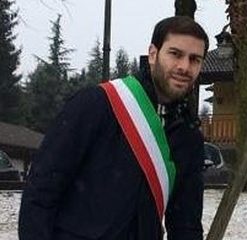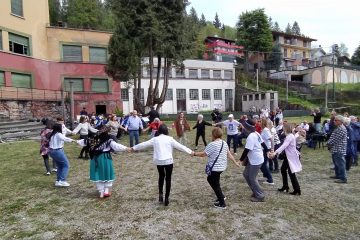After the Liberation, in Sciesopoli Selvino hospitality and welcome for many Jewish children survived the Holocaust
Written by Claudia Piccinelli. Posted in Women Shoah – Resistance – War
Another nice memory page and solidarity.
A short distance from Bergamo, on a plateau watershed between the Val Seriana and Val Brembana, is Selvino with his “Sciesopoli”. Today, it is an old building in a state of neglect. An iron gate closed, the ‘grand staircase, the façade peeling, the windows with broken glass and a clearing covered with grass and overgrown bushes.
Sciesopoli, in memory of Antonio Sciesa, shoemaker and patriot Milan shot by the Austrians at the Castello Sforzesco in 1851, in 1927 became a colony for the children of the elite Fascist Milan. In the small barracks for the soldiers of tomorrow, there is an air of war. But since 1945, after the Liberation, the fortunes are reversed, and Sciesopoli becomes a place of welcome. More than 800 Jewish children orphans, survived the labor camps and concentration camps, the death marches towards Mauthausen, Gusen, Dachau, Auschwitz, Bergen Belsen, there perform a re-birth.

Jewish refugees in Sciesopoli
Hospitality and welcome
Will Luigi Gorini, an active member of the National Liberation Committee as part of the Resistance, to seize the colony to accommodate children. The population of Selvino, from 1945 to 1948, will help the work of the host of Italian and international Jewish organizations, along with partisan organizations and military Jews who had fought for the liberation of Italy from fascism. At first the children are only about twenty. A Babel of languages: Polish, Yiddish, Hungarian, Romanian, Italian. The number is increasing day by day. Fetter Moishe, Moishe uncle-like love chiamarlo-, driver of the company, brings children into small groups from Milan, from the refugee camps of Modena, Nonantola, Magenta. Moshe Ze’iri, director and manager, Teddy Beeri, Eugenia Cohen receive them one by one on the door, note their data in the office, accompany them to the dormitories near your bed, cabinet staff, and indicate: “This will be the your home from now on. ”
The time for the care and caring
The skin burns, after clearing the hair lice with oil, very irritating. Dr. Kissin Pessia cure sunburn. Many suffer from severe forms of furunculosis. Are treated in hospitals in Bergamo or Milan. The sick with tuberculosis, in Rome. In the house, in the yard, in the grove children who spoke the same language they try to stay together in groups. The girls of thirteen, quarter past two p.m. years caring for children. They sit at the table with them, wash them, put them to sleep, pamper them. It’s cold in the house, only a cover each. The girls sleep together to warm up, stretch and coats on the covers of children.
Meal times: the sharing at the table and the theft of bread
The time is marked by the bell of the meals. Morning, noon, evening. In turn, serve at the table. In the dining room, around long tables expects silent. Not much: soup, porridge, small portions of canned meat, margarine, jam, a little fruit and vegetables brought from the village. Only a sandwich every meal. But everything is shared. Concentration camps and work, and along the death marches, the bread was life. A Selvino, children steal two or three loaves of bread from the table or from the kitchen and hide them, to feel safe.
Time job: taking care of the house
After breakfast, they are divided into working groups and study. Those who work in the morning studying the afternoon. Are dedicated to cleaning the kitchen, the bathrooms. Do laundry. Perform repairs and cook. They take care of the garden and plants. Stand guard at night.
Play time: time for herself
In the late afternoon, freedom for the games in the yard, in the park, in the field of football, table tennis, chess sets. After dinner, everyone in the hall of the theater singing, dancing, reciting humorous skits to mitigate the pain of the wounds. Joy and sadness mingle. And when the Sabbath, the house is alive with celebration.
The time of the study: self-care and care of others
Tzippora Hegger, a teacher sent Selvino, attorney pencil stubs. Visitors bring notebooks. Màlkale, thirteen years, Orthodox family, speaks and teaches Hebrew to younger children entrusted to his care. In a seventeen year old, from Auschwitz and the labor camps of the lower Silesia, they say: “Give the example.” Then he begins to tell the stories of the Bible that he remembered from his childhood. Avraham, eighteen, has a burning desire: to study! Arie Sola, thirty-five, an experience of teaching in Jewish schools in Czechoslovakia and Hungary, makes pleasant studies to children thirsty for knowledge. Write by hand some manuals. So to begin with regularity Sciesopoli language studies, literature, arithmetic, history of the Jewish people, the geography of Palestine. All animated by a deep desire to rebuild the ‘personal identity and of their own people.

Listening, empathy, comfort
Misunderstanding and resentment for their strict discipline, as Zeev and Adam: “What do you want from us? We clean the dining room? Work, still work here? “. Rebellion against the rule to get up so early in the morning, food rationing, a ban on moving from the house. To balance the firmness of Moshe Ze’iri, understanding of Dr. Pessia Kissin: after that suffering, are entitled to everything. And with a little effort, even food rations can be increased. The arrival in Selvino the driver is still a time of great excitement. The run towards. In the evening, sitting in the bottom of the bed, in the dark, a child can confide. In consolation, Uncle Moishe transmitted His optimism.
It rekindles hope
Not even two months, and already new energy burst. The first issue of the magazine “Nivenu”, “Our word” share the hope of all: immigration to Palestine. Selvino is only an intermediate step. It reads: “eradicate hatred, not only to live in community property, but also of ideals.”
The first departures
Very slim chances of immigrating legally. So from the place of Union Street, 5 in Milan begin clandestine activities for illegal immigration. On December 31, 1945, the announcement of the first departure. After four days of training on the farm of Magenta, a convoy of forty trucks with hidden 900 refugees, among them the boys of Selvino, will head up the small port of Vado Ligure, where he awaits the “Enzo Sereni.” On January 17, the ship will be intercepted. Forced to divert to the port of Haifa, later will be sent to the prison camp at Atlit. After the release, in Kibbutz Chanita will be the first group from Sciesopoli.
New meetings
In 1983, sixty of them return to Selvino. Among these, there Bisk Miriam, the daughter of Holocaust survivors in Lodz in Poland, then operators Sciesopoli Jewish. Will be imprisoned in Cyprus because intercepted by the British Mandate in illegal emigration. Miriam will be born there. In his recent trip to search for origins, in a letter to Pope Francis writes: “Preserving the memory of Sciesopoli, to honor citizens of Selvino, to tell the story of the Jewish children who survived in this sacred place have won their childhood stolen, a “new family” and above all hope. ” From the United States, where he lives, will return to Sciesopoli, along with many other children of the colonialist -this time with their children. In September, awaits another meeting with the community of Selvino, organized with the organizing committee of the petition “Why hard memory”.
Ahoron Megged, The Journey to the Promised Land. The story of the children of Selvino, Milano, Mazzotta, 1997
see link: www.noidonne.org


